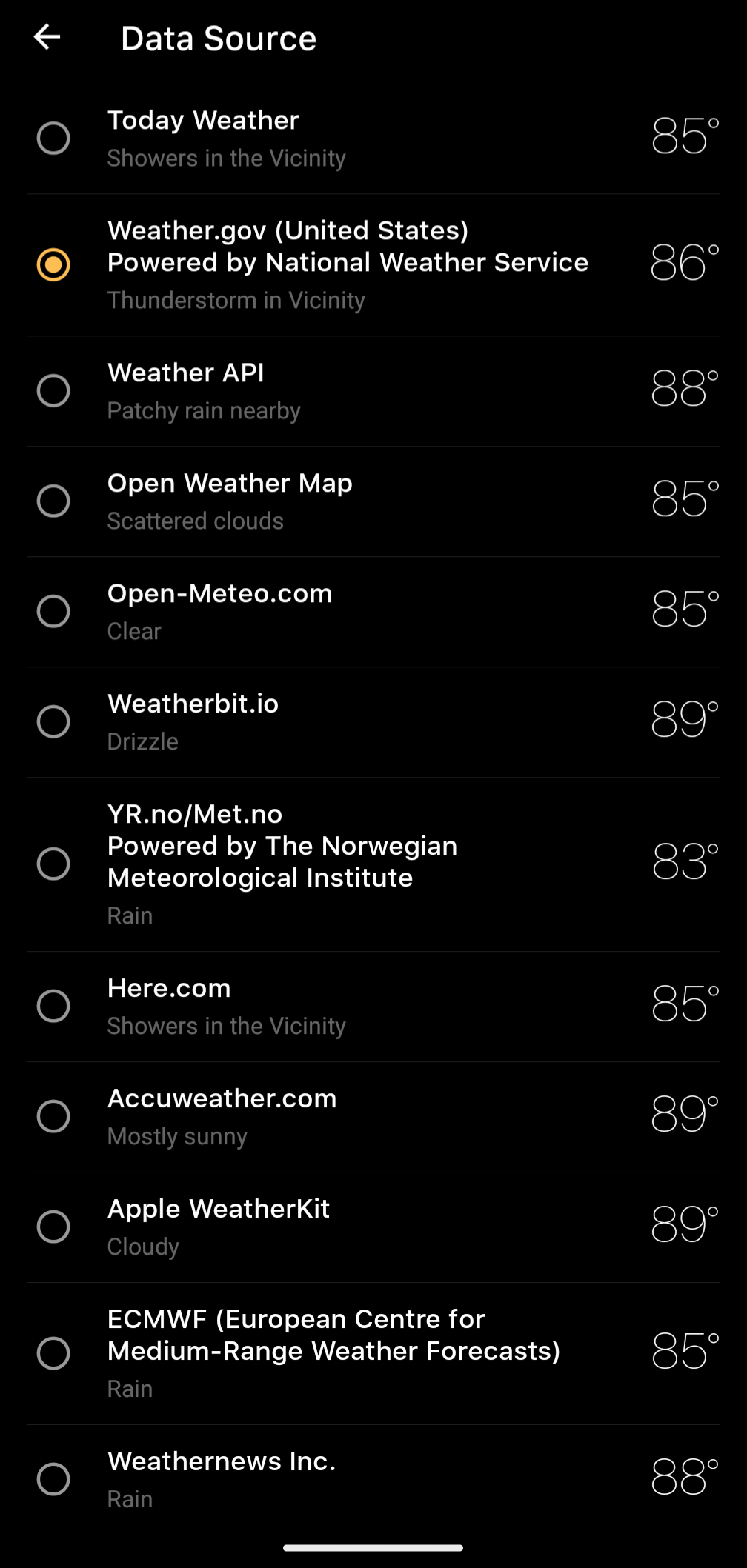I understand that weather on TV can’t be hyperlocally accurate. But a weather app on my phone has my exact GPS coordinates. Why can’t it tell me exactly when a rain cloud will be passing over my location?
It’s gotten to the point where I just use precipitation maps to figure out my rain chances for the day.
The hourly forecast is mostly useless because it’s not a chance % but a % of the area that will be raining.
MinuteCast from AccuWeather does exactly this. It looks at your location, looks at radar data for storm systems approaching your location, and estimates when precipitation will start at your location and how intense it will be. It’s generally pretty accurate, with some limitations. It seems to be pretty good for consistent rainstorms but it can get tripped up by pop-up thunderstorms, where the radar track can go suddenly from no rain to downpour. It doesn’t make predictions more then 2-3 hours out because past that timeframe it’s not easy to predict if weather will continue on its current track or change direction. Even with the limitations, I use it all the time. Mostly to tell if I should take the dogs out right away, or if I should wait an hour or two.
This is exactly what I’m looking for! I also often check the weather to get a gauge on whether it’s clear to walk my dogs. 2-3 hours ahead is perfect.
Weather.com also has real-time alert . You get notifications for rain about 30-40 minutes in advance based on specific location
deleted by creator
deleted by creator
Since people are sharing their weather apps, I use Breezy Weather! Multiple sources, lots of info, FOSS, what’s not to like. I tried multiple sources untill I found one that was the most accurate for me.
Some airports are still reporting temps once an hour, so the info you get from an app can be old and irrelevant. Also some apps use a forecast made days before, they are too cheap/busy to update it.
I notice the rain predictions are quite a bit more accurate in the cooler months. You can see a weather front traveling west to east as it comes across the country (I’m in US) and rains can last all day. During the hotter parts in summer rain clouds appear out of nowhere usually in the afternoon and rains are heavy but brief. This happened here in NE Ohio just an hour ago. There was no forecast for rain that I was aware of but suddenly we got doused for twenty minutes.
MyRadar is scary good, in my experience.
You must be 14. Science doesn’t work like that.
Maybe they are 14. They’re just trying to understand. You, however, are an asshole.
Weather prediction at point locations is extremely challenging to get right because we simply can’t observe and make predictions for every single square inch of the earth. Many weather models are run on grids with boxes about the size of a few kilometers at the smallest scale, which means that any physical process in the atmosphere that is the size of that box or smaller won’t be represented well by the model.
Specifically on your point about clouds passing over your location, cloud and precipitation formation is even more challenging. Clouds and precipitation form due to atmospheric processes ranging from hundreds of kilometers all the way down to micrometers, which practically means the weather models are making an educated guess (albeit a very good one that is informed by scientific research) about when and where clouds will form. And when a model does predict a cloud, it will cover an entire grid box.
Finally, I saw you made a comment about how machine learning should improve forecasts, and in fact it does! But the weather community is still working on data driven models (as opposed to models that solve physical atmospheric equations), and most of them are run by private companies so their output is not free. As these data driven models get better, it may be possible that they will be able to make predictions at scales less than a kilometer.
This is a really thoughtful and educational answer. I learned a lot from this. Thank you!
I just looked at my weather app (Today Weather), and the report of the current temperature varies by 6°F depending on which data set I choose. I go with the National Weather Service (federal govt).

As far as predicting precipitation, the radar seems pretty good for the next few hours. I press play on it, and it tells me what it thinks the radar will look like for the next 7 hours in 15 mins increments.
I think that predicting the weather beyond a day gets pretty difficult because the weather is too chaotic. The best they can do is to gather data from local weather stations and see how often it rained when they had these same data in the past. So basically, it’s like saying, “When the temp has been 85°F, humidity 62%, wind from WNW at 5 kts, pressure at 1016 mBar, and the date was July 29, it rained 6 times out of 10.”
NOAA sources are usually good in the US, weather.gov for a quick map and search by zip code or city, but they follow the same % system mentioned as most do
The couple apps/widgets I’ve tried haven’t been good for working with VPN unless I want to know the weather halfway around the world.
I went to Amsterdam over the weekend. The weather apps said it was gonna rain, did it fuck. I brought my puffer jacket and was almost dying from the heat until I got to the hotel room. Never had to wear it during the trip.
I am a pilot and flight instructor. I took a full year of meteorology at ERAU. Most weather forecast products presented to the general public are completely worthless, and we really should run “AccuWeather” out of business.
The temperature number they show you for what it is “now” was probably taken by the AWOS at the closest municipal airport to your location. If you’ve ever noticed like a car GPS reporting weather from three towns over and not the one you’re in right now, it’s because the town you’re in right now doesn’t have a nearby airport or it doesn’t have an AWOS.
10-day forecasts are generated by tarot cards and have no basis in reality. Actual aviation weather forecasts seldom reach out beyond 24 hours.
Your best bet for getting a complete understanding of the weather is to start by looking at the GOES satellite imagery, ie actually look at the Earth from geosynchronous orbit and look at the clouds. You know those maps with the blue lines with triangles on them and red lines with half circles and big blue Hs and big red Ls? Those are called Prognostic charts, those map where high and low pressure systems and fronts are. Look at one of those and compare them to the satellite images. Then look at Doppler radar imagery, which shows where precipitation is. Look at what it’s been doing for the last few hours, and then you can get a good sense of generally what the weather is going to do in the next few hours. Beyond that, not even God knows because the prick hasn’t decided yet.
It amazes me how some people seem to go through life not realizing weather is fundamentally chaotic.
Like, even if all you do is look out a window from time to time…
Butterfly effect. Even Hari Sheldon in the Foundation series couldn’t do that.
Psychohistory was designed for large groups. It wasn’t designed for single creatures like butterflies
No shade but I could not take the premise of that book seriously. The idea that any complex system could be mapped thousands of years into the future is so incredibly unrealistic to me that I was unable to suspend my disbelief.
I’m a massive Dune fan though so I have no leg to stand on. Hold on a second while I re-calibrate my metabolism and use my genetic heritage to recall events that happened 30000 years ago.
So, what Hari does is basically game theory on a massive scale. The larger the group, the less complexity because you’re abstracting the different possible issues individuals would have out of the problem. Instead of making it more complex, it simplifies the whole thing because all the chaotic bits cancel each other out.
And slight spoiler warning for an old story but you find out later that the whole thing isn’t just predicted ahead of time and let loose but a group of people follow along in the shadows to keep the plan on track.
It wasn’t because it couldn’t. Hari tried it and failed. Applying Psychohistory to only large enough populations was his compromise. This is mentioned in Prelude to Foundation. I think Hari specifically mentions how complex predicting weather is iirc. That’s why I mentioned it in the first place.
Just out of curiosity, why do you dislike AccuWeather?
My main beef with them is they take data from the public National Weather Service and package it for profit, and they’re backing proposed legislation that would prevent the NWS from distributing their weather data directly to the public.
Other than that, most of what AccuWeather does is make the pretty weather maps for the TV stations, and most of the way they make them pretty is by making them less accurate, complete and precise. To a pilot, for whom weather information is a critical safety tool, an AccuWeather product is a bit like a traffic light covered in a half inch thick layer of Spongebob stickers.
The NWS is already trying to measure and predict the giant ball of chaos that is the Earth’s atmosphere with probably fewer tools than they’d like, and AccuWeather takes that data and makes it worse so that it’s prettier for TV.
In conclusion, fuck AccuWeather.
I know any in my case. I’m in a black hole of into. The nearest weather station is over 30 miles away and it’s not remotely accurate for my location because of terrain changes between here and there. There isn’t even a weather station in my overly large and oddly shaped county.
We went so far as to contact the people in charge of weather stations to see if we could set one up in our yard and while there was some initial excitement from them they eventually ghosted us.
Why not buy a cheap weather station for kids that come with Bluetooth or server? There must be one with a web page on it ready to go for the less technically inclined.
Or just ask your nerd nephew to do it for you.
I am the only nerd across multiple generations. My nephew is a Hikikomori and not traveling to see me. I’d rather have a real system that connects to the network and fills the need for accurate weather in my town.
For one thing, there’s two competing weather services providing the data to countless apps in the US and one of them has more money to throw around than the other.
The weather channel has better weather predictions overall than Apple’s own weather app, as rated by Forecastadvisor.com, but is not as accurate as Accuweather is although it’s used in more apps.
Weather is about tracking and predictions. It’s never going to be completely 100% correct. But taking a hodgepodge of information from several prediction services means you’re more likely to be less accurate overall despite what people may think.
Which are the two? NOAA and what else?
NOAA is one, the US armed Forces is the other. Not including info provided from other weather agencies outside the US.
All of those weather services just pull data from NOAA. There’s no competition, besides making up stuff beyond what NOAA predicts.
If all the private company weather services were only getting their info from the NOAA we wouldn’t have such varying results most of the time. Which is basically my point. The results vary because they don’t just use the NOAA’s data and predictions. The second one is actually the US Armed Forces.









